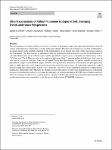Ultra-Trace Analysis of Fallout Plutonium Isotopes in Soil: Emerging Trends and Future Perspectives
| dc.contributor.author | Dowell, SM | |
| dc.contributor.author | Humphrey, OS | |
| dc.contributor.author | Blake, WH | |
| dc.contributor.author | Osano, O | |
| dc.contributor.author | Chenery, S | |
| dc.contributor.author | Watts, MJ | |
| dc.date.accessioned | 2023-10-13T11:58:37Z | |
| dc.date.issued | 2023-05-03 | |
| dc.identifier.issn | 2522-5758 | |
| dc.identifier.issn | 2522-5766 | |
| dc.identifier.uri | https://pearl.plymouth.ac.uk/handle/10026.1/21422 | |
| dc.description.abstract |
The measurement of isotopic abundances and ratio variations of plutonium can provide important information about the sources and behaviours of radiogenic isotopes in the environment. The detection of ultra-trace isotopes of plutonium is increasing interest in the scientific literature for the determination of soil erosion rates due to their long retention times in the environment. The characteristics of plutonium within the environment make it an ideal tracer for the determination of soil redistribution rates and its robustness presents the opportunity to replace more commonly used radioisotopes such as 137Cesium and 210Lead. However, ultra-trace analysis of plutonium (fg g−1) presents analytical challenges which must be overcome in a variety of soil types. Inductively Coupled Plasma Mass Spectrometry has proven valuable for detection of plutonium in a range of environmental samples. However, severe polyatomic interferences from uranium isotopes significantly limits its application. Due to the improvements in detection sensitivity and reaction cell technology, inductively coupled plasma tandem mass spectrometry, which is also commonly referred to as triple quadrupole inductively coupled plasma tandem mass spectrometry (ICP-MS/MS), has emerged as an exceptional tool for ultra-trace elemental analysis of plutonium isotopes in environmental samples overcoming the limitations of standard quadrupole ICP-MS such as limited sensitivity and cost of analysis. In this review, common methods reported in the literature for the separation and subsequent detection of plutonium isotopes are compared to recent advances in analysis using ICP-MS/MS technology. | |
| dc.format.extent | 2429-2444 | |
| dc.language | en | |
| dc.publisher | Springer Science and Business Media LLC | |
| dc.subject | Plutonium | |
| dc.subject | Soil erosion | |
| dc.subject | Mass spectrometry | |
| dc.subject | Radiometric | |
| dc.subject | ICP-MS | |
| dc.subject | MS | |
| dc.title | Ultra-Trace Analysis of Fallout Plutonium Isotopes in Soil: Emerging Trends and Future Perspectives | |
| dc.type | journal-article | |
| dc.type | Review | |
| dc.type | Early Access | |
| plymouth.issue | 5 | |
| plymouth.volume | 6 | |
| plymouth.publication-status | Published | |
| plymouth.journal | Chemistry Africa | |
| dc.identifier.doi | 10.1007/s42250-023-00659-7 | |
| plymouth.organisational-group | |Plymouth | |
| plymouth.organisational-group | |Plymouth|Research Groups | |
| plymouth.organisational-group | |Plymouth|Faculty of Science and Engineering | |
| plymouth.organisational-group | |Plymouth|Faculty of Science and Engineering|School of Geography, Earth and Environmental Sciences | |
| plymouth.organisational-group | |Plymouth|Research Groups|Marine Institute | |
| plymouth.organisational-group | |Plymouth|REF 2021 Researchers by UoA | |
| plymouth.organisational-group | |Plymouth|Users by role | |
| plymouth.organisational-group | |Plymouth|Users by role|Academics | |
| plymouth.organisational-group | |Plymouth|REF 2021 Researchers by UoA|UoA14 Geography and Environmental Studies | |
| plymouth.organisational-group | |Plymouth|Admin Group - REF | |
| plymouth.organisational-group | |Plymouth|Admin Group - REF|REF Admin Group - FoSE | |
| plymouth.organisational-group | |Plymouth|Users by role|Researchers in ResearchFish submission | |
| dcterms.dateAccepted | 2023-03-21 | |
| dc.date.updated | 2023-10-13T11:58:36Z | |
| dc.rights.embargodate | 2023-10-14 | |
| dc.identifier.eissn | 2522-5766 | |
| rioxxterms.versionofrecord | 10.1007/s42250-023-00659-7 |


